Characterization, ecological distribution, and population dynamics of Saccharomyces sensu stricto killer yeasts in the spontaneous grape must fermentations of southwestern Spain
- PMID: 22101056
- PMCID: PMC3264118
- DOI: 10.1128/AEM.06518-11
Characterization, ecological distribution, and population dynamics of Saccharomyces sensu stricto killer yeasts in the spontaneous grape must fermentations of southwestern Spain
Abstract
Killer yeasts secrete protein toxins that are lethal to sensitive strains of the same or related yeast species. Among the four types of Saccharomyces killer yeasts already described (K1, K2, K28, and Klus), we found K2 and Klus killer yeasts in spontaneous wine fermentations from southwestern Spain. Both phenotypes were encoded by medium-size double-stranded RNA (dsRNA) viruses, Saccharomyces cerevisiae virus (ScV)-M2 and ScV-Mlus, whose genome sizes ranged from 1.3 to 1.75 kb and from 2.1 to 2.3 kb, respectively. The K2 yeasts were found in all the wine-producing subareas for all the vintages analyzed, while the Klus yeasts were found in the warmer subareas and mostly in the warmer ripening/harvest seasons. The middle-size isotypes of the M2 dsRNA were the most frequent among K2 yeasts, probably because they encoded the most intense K2 killer phenotype. However, the smallest isotype of the Mlus dsRNA was the most frequent for Klus yeasts, although it encoded the least intense Klus killer phenotype. The killer yeasts were present in most (59.5%) spontaneous fermentations. Most were K2, with Klus being the minority. The proportion of killer yeasts increased during fermentation, while the proportion of sensitive yeasts decreased. The fermentation speed, malic acid, and wine organoleptic quality decreased in those fermentations where the killer yeasts replaced at least 15% of a dominant population of sensitive yeasts, while volatile acidity and lactic acid increased, and the amount of bacteria in the tumultuous and the end fermentation stages also increased in an unusual way.
Figures
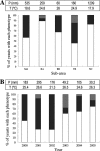
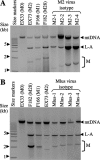
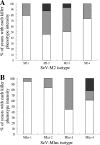
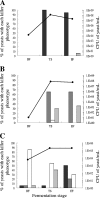
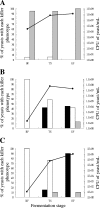

Similar articles
-
Relationships and Evolution of Double-Stranded RNA Totiviruses of Yeasts Inferred from Analysis of L-A-2 and L-BC Variants in Wine Yeast Strain Populations.Appl Environ Microbiol. 2017 Feb 1;83(4):e02991-16. doi: 10.1128/AEM.02991-16. Print 2017 Feb 15. Appl Environ Microbiol. 2017. PMID: 27940540 Free PMC article.
-
L-A-lus, a new variant of the L-A totivirus found in wine yeasts with Klus killer toxin-encoding Mlus double-stranded RNA: possible role of killer toxin-encoding satellite RNAs in the evolution of their helper viruses.Appl Environ Microbiol. 2013 Aug;79(15):4661-74. doi: 10.1128/AEM.00500-13. Epub 2013 May 31. Appl Environ Microbiol. 2013. PMID: 23728812 Free PMC article.
-
A new wine Saccharomyces cerevisiae killer toxin (Klus), encoded by a double-stranded rna virus, with broad antifungal activity is evolutionarily related to a chromosomal host gene.Appl Environ Microbiol. 2011 Mar;77(5):1822-32. doi: 10.1128/AEM.02501-10. Epub 2011 Jan 14. Appl Environ Microbiol. 2011. PMID: 21239561 Free PMC article.
-
Biology of killer yeasts.Int Microbiol. 2002 Jun;5(2):65-71. doi: 10.1007/s10123-002-0066-z. Int Microbiol. 2002. PMID: 12180782 Review.
-
Viral induced yeast apoptosis.Biochim Biophys Acta. 2008 Jul;1783(7):1413-7. doi: 10.1016/j.bbamcr.2008.01.017. Epub 2008 Feb 7. Biochim Biophys Acta. 2008. PMID: 18291112 Review.
Cited by
-
Relationships and Evolution of Double-Stranded RNA Totiviruses of Yeasts Inferred from Analysis of L-A-2 and L-BC Variants in Wine Yeast Strain Populations.Appl Environ Microbiol. 2017 Feb 1;83(4):e02991-16. doi: 10.1128/AEM.02991-16. Print 2017 Feb 15. Appl Environ Microbiol. 2017. PMID: 27940540 Free PMC article.
-
Mechanisms Involved in Interspecific Communication between Wine Yeasts.Foods. 2021 Jul 27;10(8):1734. doi: 10.3390/foods10081734. Foods. 2021. PMID: 34441512 Free PMC article. Review.
-
High-yield expression in Escherichia coli, purification and application of budding yeast K2 killer protein.Mol Biotechnol. 2014 Jul;56(7):644-52. doi: 10.1007/s12033-014-9740-6. Mol Biotechnol. 2014. PMID: 24532228
-
Yeast β-1,6-glucan is a primary target for the Saccharomyces cerevisiae K2 toxin.Eukaryot Cell. 2015 Apr;14(4):406-14. doi: 10.1128/EC.00287-14. Epub 2015 Feb 20. Eukaryot Cell. 2015. PMID: 25710965 Free PMC article.
-
L-A-lus, a new variant of the L-A totivirus found in wine yeasts with Klus killer toxin-encoding Mlus double-stranded RNA: possible role of killer toxin-encoding satellite RNAs in the evolution of their helper viruses.Appl Environ Microbiol. 2013 Aug;79(15):4661-74. doi: 10.1128/AEM.00500-13. Epub 2013 May 31. Appl Environ Microbiol. 2013. PMID: 23728812 Free PMC article.
References
-
- Altschul SF, Gish W, Miller W, Myers EW, Lipman DJ. 1990. Basic local alignment search tool. J. Mol. Biol. 215:403–410 - PubMed
-
- Barre P. 1980. Role du facteur killer dans la concurrence entre souches de levures. Bull. O. I. V. 593–594:560–567
-
- Bussey H. 1972. Effects of yeast killer factors on sensitive cells. Nat. New Biol. 235:73–75 - PubMed
-
- Carrau FM, Neirotti EN, Giogia O. 1993. Stuck wine fermentation: effect of killer/sensitive yeast interactions. J. Ferment. Bioeng. 76:67–69
Publication types
MeSH terms
Substances
LinkOut - more resources
Full Text Sources
Molecular Biology Databases

